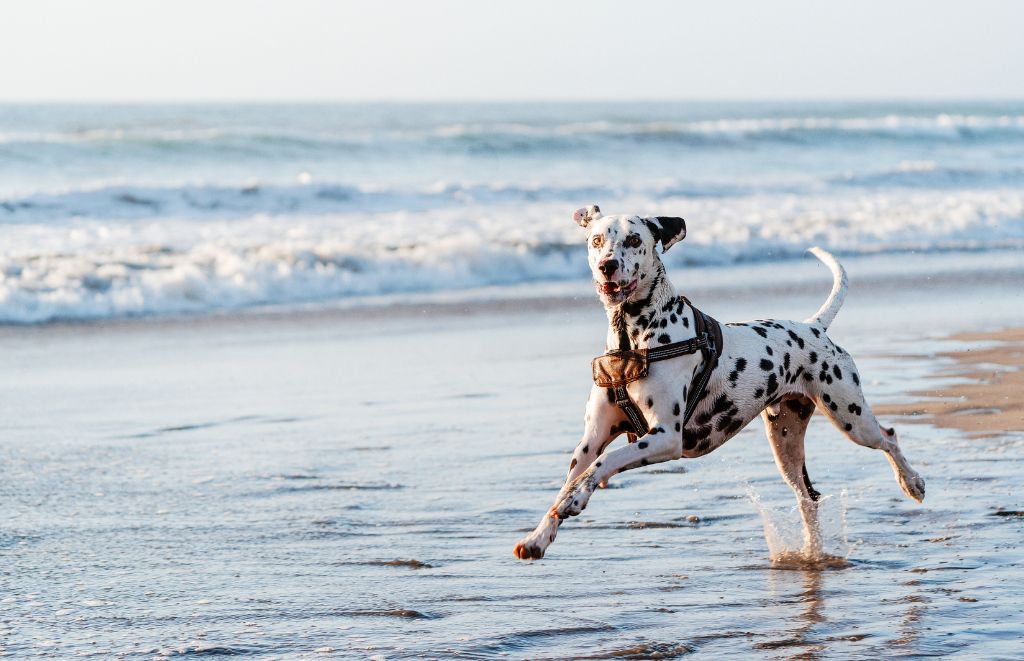Have you ever been excitedly calling your dog’s name, only to be met with a blank stare, a yawn, or worse—complete indifference? You’re not alone. Many dog owners have experienced this frustrating scenario and wondered, “Why does my dog ignore me?” It can be disheartening, especially when you feel like you’re being overlooked by your furry friend. But don’t worry—there’s more going on here than meets the eye.
In this blog, we’ll dive into the intricacies of dog behavior, communication, and how you can improve your relationship with your canine companion. So, let’s get into it!
Understanding Dog Communication
How Do Dogs Communicate Differently Than Humans?
Dogs and humans communicate in entirely different ways. While we rely heavily on spoken language, dogs use a combination of body language, facial expressions, vocalizations, and even scent. To truly understand why your dog might be ignoring you, it’s essential to recognize that they are not just being difficult. They are simply processing information differently.
For example, when your dog looks away as you talk to them, it might seem like they’re ignoring you, but in dog language, this could be a calming signal—a way of saying they don’t feel threatened. Dogs often use subtle cues that are easy to miss, so what feels like ignorance might just be a miscommunication.
Why Do Dogs Tune Out Human Speech?
Unlike humans, dogs don’t naturally understand our words. They’re more attuned to the tone of our voice and the emotions behind it. If you’ve ever seen your dog respond enthusiastically to a high-pitched, excited voice or cower when you’re upset, you’ve seen this in action.
Dogs are excellent at picking up on our emotions, but the specific words we use? Not so much. If your dog seems to tune out your speech, it might be because they haven’t associated what you’re saying with something meaningful—or perhaps you’re using the wrong tone or context, causing confusion.
Reasons for Ignoring
What Are the Common Reasons Dogs Ignore Their Owners?
There are several reasons your dog might be ignoring you, and understanding these can help you address the behavior. Here are some common culprits:
- Lack of Training: If your dog hasn’t been properly trained to respond to commands, they simply might not know what you want from them.
- Distractions: Dogs are easily distracted by their environment. If there are more interesting things around, like a squirrel, other dogs, or new smells, your dog might not even notice you’re trying to get their attention.
- Inconsistent Commands: If different family members use different words for the same command, or if you’re inconsistent with your expectations, your dog might be confused about what you want.
- Health Issues: If your dog suddenly starts ignoring you, it might be worth a trip to the vet. Hearing loss, pain, or other health problems can affect their behavior.
- Age: Puppies and senior dogs often have their own unique sets of behavioral challenges. Puppies are still learning, while older dogs might be experiencing cognitive decline or hearing loss.
How Does a Dog’s Environment Affect Its Behavior?
Your dog’s environment plays a significant role in their behavior. A stimulating environment with plenty of physical and mental exercise opportunities can keep your dog engaged and responsive. On the other hand, a lack of stimulation, or a stressful environment, can lead to boredom, anxiety, and even ignoring commands.
It’s essential to provide your dog with a balanced environment that includes regular playtime, exercise, and mental challenges. Speaking of which, if you’re looking to enhance your dog’s environment with some fun and stylish accessories, check out Printies, we have a print-on-demand pet shop offering personalized dog accessories. Whether it’s a custom dog collar or a cozy pet blanket, these items can help make your dog’s space more enjoyable and engaging.
-
 Blue Gingham Dog Collar$22.50
Blue Gingham Dog Collar$22.50 -
 Cane Corso Personalized Dog Tag$18.07
Cane Corso Personalized Dog Tag$18.07 -
 Bulldog Personalized Dog Tag$18.07
Bulldog Personalized Dog Tag$18.07 -
 Boxer Personalized Dog Tag$18.07
Boxer Personalized Dog Tag$18.07 -
 Basset Hound Personalized Dog Tag$18.07
Basset Hound Personalized Dog Tag$18.07 -
 Welsh Springer Spaniel Personalized Dog Tag$18.07
Welsh Springer Spaniel Personalized Dog Tag$18.07 -
 Pug Personalized Dog Tag$18.07
Pug Personalized Dog Tag$18.07 -
 Great Pyrenees Personalized Dog Tag$18.07
Great Pyrenees Personalized Dog Tag$18.07 -
 German Shorthaired Pointer Personalized Dog Tag$18.07
German Shorthaired Pointer Personalized Dog Tag$18.07
Training and Engagement
How Can Training Techniques Influence a Dog’s Response?
Training is crucial in shaping your dog’s behavior. Positive reinforcement—rewarding your dog when they respond correctly—can significantly improve their responsiveness. Dogs are more likely to engage when they associate responding to you with something positive, like treats, toys, or praise.
Consistency is key. Ensure that everyone in the household uses the same commands and rewards the same behavior. Over time, this consistency helps your dog understand what is expected of them, reducing instances of them “ignoring” you.
What Is a “Poisoned Cue” and How Does It Affect My Dog?
A “poisoned cue” occurs when a command that used to elicit a positive response becomes associated with something negative. For example, if you always call your dog to you before giving them a bath (which they hate), they might start ignoring the “come” command because they’ve learned to associate it with something unpleasant.
To fix this, you’ll need to recondition your dog by pairing the command with positive experiences. Try calling your dog and rewarding them with a treat or a fun game, so they learn to see the cue as something good again.
Building a Stronger Bond
How Can I Strengthen My Relationship with My Dog?
Building a stronger bond with your dog is one of the best ways to ensure they are responsive to you. Spend quality time with your dog—whether that’s through play, training sessions, or just relaxing together. The more positive experiences you share, the more your dog will want to engage with you.
At Printies, we believe that every moment with your pet is an opportunity to strengthen your bond. That’s why we offer a range of customizable pet accessories like pet bandanas, blankets, and ID tags that can make your shared moments even more special. These personalized items are not just functional; they also serve as a fun way to celebrate your dog’s unique personality.
-
 Cane Corso Personalized Dog Tag$18.07
Cane Corso Personalized Dog Tag$18.07 -
 Bulldog Personalized Dog Tag$18.07
Bulldog Personalized Dog Tag$18.07 -
 Boxer Personalized Dog Tag$18.07
Boxer Personalized Dog Tag$18.07 -
 Basset Hound Personalized Dog Tag$18.07
Basset Hound Personalized Dog Tag$18.07 -
 Welsh Springer Spaniel Personalized Dog Tag$18.07
Welsh Springer Spaniel Personalized Dog Tag$18.07 -
 Pug Personalized Dog Tag$18.07
Pug Personalized Dog Tag$18.07 -
 Great Pyrenees Personalized Dog Tag$18.07
Great Pyrenees Personalized Dog Tag$18.07 -
 German Shorthaired Pointer Personalized Dog Tag$18.07
German Shorthaired Pointer Personalized Dog Tag$18.07 -
 American Bulldog Personalized Dog Tag$18.07
American Bulldog Personalized Dog Tag$18.07
What Activities Can Help Increase My Dog’s Engagement?
Engaging your dog doesn’t have to be a chore. Here are some activities that can help increase their engagement:
- Interactive Play: Games like fetch, tug-of-war, or hide and seek are great ways to get your dog’s attention and keep them engaged.
- Training Sessions: Short, daily training sessions using positive reinforcement can keep your dog mentally stimulated and responsive.
- Outdoor Adventures: Take your dog for walks in new places or introduce them to different environments. This not only provides physical exercise but also mental stimulation.
- Puzzle Toys: Toys that challenge your dog to think and solve problems can be great for keeping their mind sharp.
- Socialization: Allowing your dog to interact with other dogs and people can improve their overall behavior and make them more attentive to you.
Behavioral Considerations
How Does a Dog’s Past Experience Impact Its Behavior?
A dog’s past experiences play a significant role in their current behavior. A dog that has experienced trauma, neglect, or inconsistent training may be more likely to ignore commands or appear aloof. Understanding your dog’s history can provide insights into their behavior and help you tailor your approach to their needs.
If you’ve adopted a dog with a challenging past, patience is critical. Gradually build trust and use positive reinforcement to encourage desired behaviors. Over time, with consistent love and care, many dogs can overcome their past and become more responsive.
Why Is Consistent Leadership Important for My Dog?
Dogs thrive on structure and routine. Consistent leadership helps your dog understand their place in the pack (your family) and what’s expected of them. If your dog sees you as a reliable and consistent leader, they’re more likely to listen and respond to your commands.
This doesn’t mean being harsh or authoritarian. Instead, it’s about setting clear boundaries, using consistent commands, and rewarding good behavior. When your dog knows what to expect, they’ll feel more secure and be more likely to engage with you positively.
Practical Solutions
What Steps Can I Take to Get My Dog to Listen?
If your dog is ignoring you, there are practical steps you can take to improve their responsiveness:
- Use High-Value Rewards: Find out what motivates your dog the most—whether it’s a particular treat, a favorite toy, or praise—and use it to reinforce good behavior.
- Stay Calm and Patient: Dogs can sense our emotions, and if you’re frustrated, they might shut down. Keep your commands calm and clear, and be patient as your dog learns.
- Break Training into Small Steps: If your dog is struggling with a command, break it down into smaller steps and reward them as they make progress.
- Increase Exercise: A tired dog is often a more attentive dog. Ensure your dog gets plenty of physical and mental exercise.
- Assess Their Environment: If your dog is distracted, try training in a quieter, less stimulating environment before gradually introducing more distractions.
How Can I Change My Approach to Improve Communication with My Dog?
Improving communication with your dog often requires changing your approach. Here are some tips:
- Be Consistent: Use the same words, tone, and body language for commands. Inconsistencies can confuse your dog.
- Observe Their Body Language: Pay attention to your dog’s cues. If they seem stressed or distracted, it might not be the best time to train or engage.
- Make it Fun: Training should be an enjoyable experience for both you and your dog. Keep sessions short, positive, and end on a high note.
- Incorporate Play: Use toys and playtime as part of your training. For instance, if your dog loves playing with a particular toy, use it as a reward for following commands.
Behavioral Considerations
Why Is Consistent Leadership Important for My Dog?
Dogs look to their owners for guidance and stability. Consistent leadership doesn’t mean being a strict disciplinarian; rather, it’s about setting clear rules and expectations that help your dog feel secure. When your dog understands the boundaries and knows what’s expected of them, they’re more likely to follow your lead.
If you’re inconsistent—sometimes letting behaviors slide and other times reprimanding them—your dog may become confused about what they should be doing. This inconsistency can lead to anxiety and make them more likely to ignore commands. Consistency, on the other hand, builds trust and respect, leading to a happier, more well-behaved dog.
Building a Stronger Bond
How Can I Strengthen My Relationship with My Dog?
Building a strong bond with your dog goes beyond basic training. It’s about creating a deep connection through trust, love, and shared experiences. Here are a few more ways to strengthen your relationship:
- Daily Routines: Dogs thrive on routine. Regular feeding, walking, and playtimes help create a sense of security and predictability. Your dog will come to rely on these moments as times of connection.
- Grooming: Regular grooming isn’t just about keeping your dog clean; it’s also a bonding activity. Brushing your dog, trimming their nails, and even simple tasks like cleaning their ears can become moments of trust and care.
- Learn New Tricks Together: Teaching your dog new tricks or commands is not only mentally stimulating for them but also a great way to bond. Plus, it reinforces their ability to listen to you in different situations.
- Personalized Care: Tailoring your dog’s environment to their specific needs can make a big difference. At Printies, our customizable accessories like pet mats and pet feeding mats ensure that even everyday activities like eating are done in style and comfort.
What Activities Can Help Increase My Dog’s Engagement?
To keep your dog engaged, it’s important to introduce activities that cater to their natural instincts and energy levels. Here are some additional ideas:
- Agility Training: Set up a mini agility course in your backyard or local park. This type of training challenges your dog both mentally and physically, keeping them focused and engaged.
- Scent Games: Dogs have an incredible sense of smell, so why not use it? Hide treats around your home or yard and encourage your dog to find them. This type of game taps into their natural foraging instincts and keeps their mind active.
- Obedience Classes: Enrolling in an obedience class can provide structured learning and help you and your dog work together in a controlled environment. Plus, it’s a great way for your dog to socialize with other dogs.
- Pet Accessories: Using engaging and stimulating pet accessories, like the ones offered at Printies, can make everyday activities more exciting. For instance, our dog leashes are not just functional but also stylish, making your daily walks something to look forward to for both you and your dog.
Conclusion
Understanding why your dog might be ignoring you requires a mix of patience, observation, and sometimes a little bit of trial and error. By learning to communicate more effectively, being consistent in your training, and using the right tools and techniques, you can build a stronger, more responsive relationship with your furry friend.
Remember, your dog isn’t ignoring you out of spite—they’re just communicating in their own way. By meeting them halfway, and perhaps with a little help from the high-quality, personalized accessories at Printies, you can ensure that your dog feels loved, engaged, and eager to listen.
Whether you’re reinforcing good behavior with a custom treat bowl, creating a cozy space with a personalized blanket, or just adding a bit of flair to your walks with a stylish leash, Printies is here to help you and your dog express your unique bond. After all, a happy, engaged dog is one that will never want to ignore you again!
Sources and References
- Schade, Victoria. “Why Does My Dog Ignore Me?” Petmd.com, PetMD, July 2024, www.petmd.com/dog/behavior/why-does-my-dog-ignore-me. Accessed 15 Aug. 2024.
- Training Tracks. “Why Does My Dog Ignore Me? – Training Tracks.” Training Tracks, 24 May 2017, trainingtracks.com/2017/05/24/why-does-my-dog-ignore-me/. Accessed 15 Aug. 2024.
















